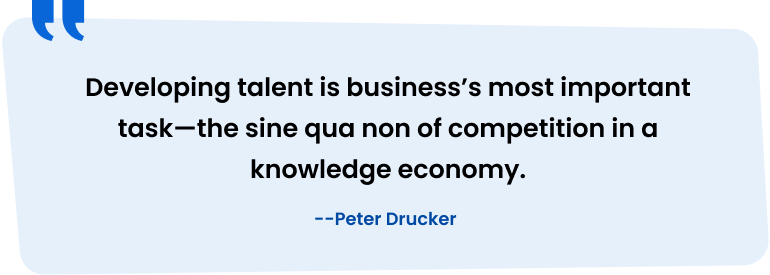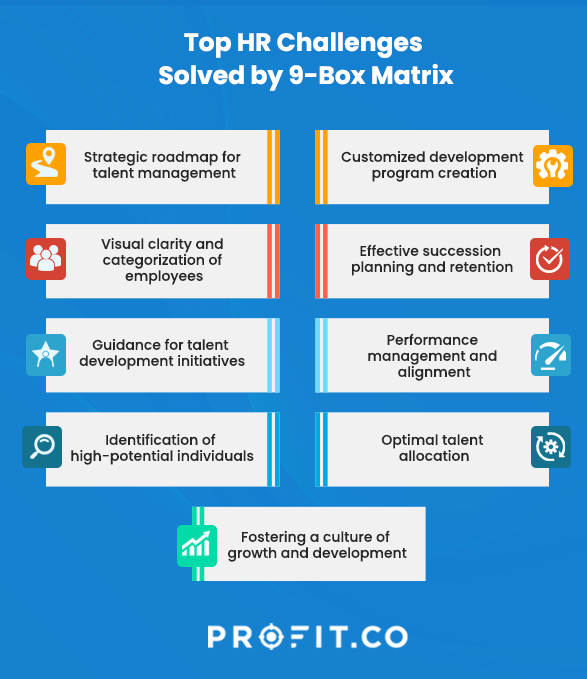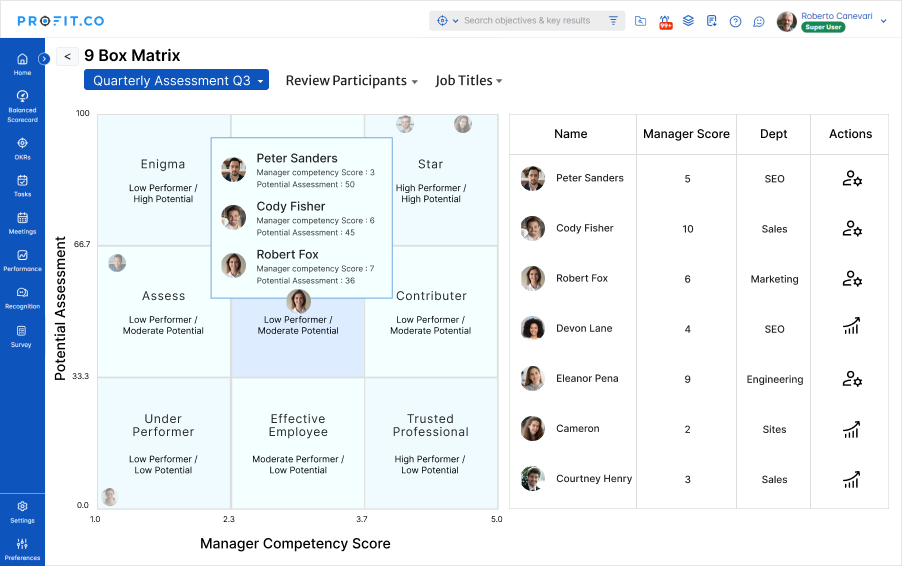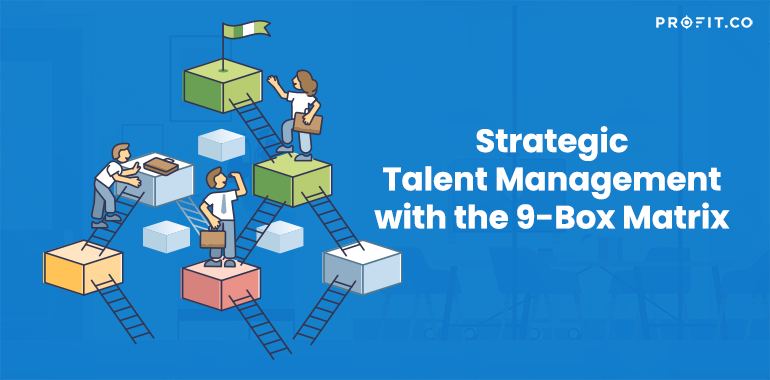Table of Contents:
- What is the 9-Box Matrix?
- How can the 9-box matrix solve the challenges of the HR department?
- 3 Steps to Use a 9-Box Talent Review Grid
- Decoding the 9 Boxes
- Introducing the 9-Box Matrix in Profit.co
- Shortcomings of the 9-Box Matrix
- How Profit.co Addresses These Shortcomings?
- Frequently Asked Questions
- Conclusion
Have you ever wondered how best to harness your team’s full potential without getting lost in spreadsheets and performance reviews?
Well, you’re not alone! Many forward-thinking businesses share this challenge. It’s all about finding, nurturing, and retaining the right people to drive business growth. To spot those high-potential employees and map out strategies for their growth, you need structured talent evaluation to pave the way for a dynamic and thriving workforce!
When HR looks for a more structured approach, it assesses employees in two key aspects.
1. Employee Performance
2. Employee Potential
Checking performance is all about ensuring the team’s performance is on point and getting the recognition and rewards they deserve for their hard work. HR also looks at the future for those high-performing stars who have the potential to become future leaders. This two-pronged approach, focusing on boosting performance and identifying future leaders, does wonders for job satisfaction and employee retention. And in this journey, HR often turns to a handy tool – the 9-box grid. It’s a simple yet effective way to sort employees based on their performance and potential.
What is the 9-Box Matrix?
The 9 Box Matrix, often called the Performance-Potential Matrix, is a versatile and powerful tool in talent management and human resources. It visually represents employees’ performance and potential, aiding organizations in making informed decisions about talent development and succession planning.
How can the 9-box matrix solve the challenges of the HR department?
It serves as a strategic roadmap to navigate the complexities of an organization’s talent management and employee development.
Succession planning and retention
- Identifies potential successors for critical roles, minimizing disruptions and ensuring a smooth leadership transition.
- Provides a commitment to employee development and growth, contributing to higher satisfaction and retention rates.

Talent identification and development
- It helps pinpoint individuals with exceptional potential who may be ready for more significant challenges and leadership roles.
- Highlights those needing additional training, mentoring, or coaching to reach their full potential.
- Guides the creation of customized development programs tailored to individual strengths and growth areas.

Performance management and alignment
- Provides a framework for focused discussions about performance, potential, and career aspirations, fostering open communication and alignment between managers and employees.
- Helps ensure that individual development plans are aligned with overall business strategies and priorities.

Visual clarity and strategic insights
- Categorizes employees into nine distinct quadrants, representing different combinations of performance and potential, enabling quick identification of strengths and gaps within the workforce.
- Guides strategic talent management initiatives, succession planning, and resource allocation of individual capabilities.

Culture of growth and development
- Encourages continuous learning and development by emphasizing the importance of potential and future contributions, fostering a culture of growth.
- Provides a roadmap for individuals to participate actively in their career growth and advancement.

3 Steps to Use a 9-Box Talent Review Grid
1. Evaluate Employee Performance
Begin by assessing the employee’s performance. This can involve reviewing performance reviews, self-evaluations, 360-degree reviews, or utilizing talent management systems.
2. Managerial Assessment
Managers play a pivotal role in this process. They rank employees based on their performance and behavior.
Performance Categories
- Employees are sorted into three groups based on their performance: low, medium, or high performers.
- Low performers need help to meet job requirements and consistently miss assigned KPIs or benchmarks.
- Medium performers partially meet expectations and complete job requirements about half the time.
- High performers are the standouts. They consistently meet and often exceed all necessary benchmarks and job duties.

3. Leadership Potential
These performance rankings are then shared with upper management and leaders who evaluate team members based on various leadership traits for effective talent management. It’s not about creating competition but recognizing and nurturing potential leaders, which is fundamental to potential assessment.
Key traits to look for include
- Independent development, where employees take initiative in their roles, demonstrating a proactive approach to personal and professional growth.
- Responsibility is another critical aspect, where individuals take ownership of successes and failures, showing a readiness to lead.
- The ability to bring solutions to conversations, keeping cool in challenging situations, and active listening are markers of a good leader, indicating a person’s capability to handle complex challenges while maintaining team morale.
- Initiative and introspection are also essential. Employees who willingly take on challenging projects or tasks and those capable of self-analysis indicate potential for leadership roles.
- Finally, going beyond what is necessary, as shown by a desire to expand one’s duties and continuously learn, highlights an employee’s drive and ambition, which are critical qualities in future leaders.
According to an article in the Harvard Business Review titled “How to Keep Your Top Talent,” merely 30% of current high performers are considered high potential. The remaining 70% may excel in their current roles but lack essential elements for future success. In summary, the 9-box grid isn’t about competition; it’s a tool to spot talent potential and nurture growth and development. Transparency and a focus on improvement are crucial to maximizing this valuable talent management tool.

Decoding the 9 Boxes
In employee evaluation, HR and managers collaboratively utilize the 9-box grid, where the x-axis represents an employee’s current performance, and the y-axis indicates their potential for future growth and development. The 9-box grid is structured into the following categories or segments:
- Low Performer, High Potential: These employees currently underperform but have significant potential for growth. They may be in a role that doesn’t fully utilize their skills or may need development and coaching.
- Low Performer, Moderate Potential: These employees are not meeting current expectations and have moderate potential for future roles. They may benefit from targeted training and clear performance goals.
- Low Performer, Low Potential: This category’s employees struggle with their roles and show limited growth potential. Strategies include reevaluation of role fit or intensive performance improvement plans.
- Moderate Performer, High Potential: These are solid contributors with a high capacity to grow. They are ideal candidates for leadership development programs.
- Moderate Performer, Moderate Potential: Reliable performers who do well in their current roles but may not be suited for significant advancement.
- Moderate Performer, Low Potential: These employees meet job expectations but have limited potential or desire for future growth. They may excel in their current roles without seeking advancement.
- High Performer, High Potential: Star employees who excel and show excellent leadership potential. Ideal candidates for succession planning and advanced development opportunities.
- High Performer, Moderate Potential: These are strong performers in their current roles with moderate potential for further growth. They can be key players in their existing capacities.
- High Performer, Low Potential: Employees who excel in their roles may need more capacity or desire to take on more complex roles. They can be recognized and rewarded for their current contributions.

Introducing the 9-Box Matrix in Profit.co
Following our in-depth exploration of the 9-Box Matrix as a strategic tool for talent management, let’s explore how this robust framework is integrated into Profit.co’s workspace management system, enhancing its functionality for streamlined talent assessment. Profit.co’s 9-Box Matrix, a key feature within its comprehensive Performance Management Software, offers robust personalization options. This tool allows you to not only name your matrix and define specific user access but also seamlessly integrate with the broader PMS dashboards. This integration ensures that all relevant data is accessible and interactive, exclusively to authorized personnel, enhancing the efficiency and effectiveness of your talent management strategies.

Functional Details
- The X-axis in Profit.co’s 9-box matrix is designed to showcase current performance levels, offering customization options to reflect self-performance ratings, managerial competency levels, and various other performance metrics. Meanwhile, the Y-axis is dedicated to Potential Assessment, providing flexibility to forecast team potential and other factors indicative of an employee’s future growth and advancement prospects. Take the case of a multinational corporation that integrates the X-axis (Performance Score) and Y-axis (Potential Assessment) within Profit.co’s 9-box matrix to holistically evaluate and develop its project management team across various departments. This approach combines assessing current performance levels with predicting future growth capacity to inform strategic talent management decisions. By analyzing both axes, the corporation identifies a group of project managers who are performing exceptionally well currently and exhibit a high potential for future leadership roles. This integrated approach facilitates tailored development plans, aligning individual growth with organizational goals and preparing the organization for its expansion phase.
- Users can engage the Formula toggle to input custom attributes. This feature allows for the tailoring of the matrix to better suit specific organizational requirements and employee evaluation criteria. Take the example of a healthcare provider customizing the 9-box matrix to include attributes specific to patient care and medical knowledge. This allows for a more nuanced staff evaluation, focusing on areas critical to healthcare outcomes.
- There are options to edit and match the plotted factors with their descriptions, ensuring the matrix aligns perfectly with your organization’s unique needs and language.
- An educational institution adapts the matrix to reflect academic performance and teaching potential. This ensures that the evaluation criteria resonate with the institution’s values and goals, making the assessment more relevant to educators.
- Based on individual scores, employees are categorized and plotted in the matrix. This categorization follows predefined criteria, enhancing the clarity and accuracy of talent assessment. A retail chain can use this feature to categorize store managers based on their performance and potential, using the matrix to identify candidates for a fast-tracked leadership development program designed to prepare the next generation of regional managers. Employees are identified in distinct categories unique to Profit.co : Enigma, Growth Employee, Star, Assess, Core Employee, High Impact Contributor, Under Performer, Effective Employee, and Trusted Employee. A fast-growing tech startup with various roles, from software developers and UX designers to sales and marketing professionals scaling rapidly, faces the dual challenge of maintaining an innovation pace and managing a diversifying team. The HR department seeks to implement a strategic talent management system to ensure the right talent is in the right roles and to foster a culture of growth and high performance. They decide to utilize Profit.co’s 9-box matrix, specifically leveraging its unique employee categorization, to achieve this.
Application
- Enigma: A newly hired data scientist shows exceptional skill but hasn’t had a chance to prove their potential in projects fully. Plans are made for strategic project assignments to assess fit and potential more accurately.
- Growth Employee: A junior marketing analyst demonstrates rapid improvement and eagerness to learn. They are enrolled in a fast-track development program to expand their skills and responsibilities.
- Star: A senior developer consistently exceeds expectations and shows leadership potential. They are considered for leading an innovation team.
- Core Employee: The backbone of the development team, reliable and consistently good performers, are given opportunities for peer mentoring, recognizing their value to the team.
- High Impact Contributor: A sales executive with a strong track record of exceeding targets is identified for a strategic sales initiative to enter new markets.
- Under Performer: A project manager struggling with recent project deliveries is offered a performance improvement plan alongside coaching to address specific challenges.
- Effective Employee: Solid performers in customer support are recognized for their steady contribution and are encouraged through recognition programs.
- Trusted Employee: A long-serving HR manager known for their reliability and deep company knowledge is involved in strategic planning sessions to leverage their insights for organizational development.
Outcome
Leveraging Profit.co’s distinct employee categories, the tech startup streamlines its talent management processes and fosters a culture that values growth, performance, and potential. This strategic approach ensures the startup remains agile and innovative, with a team fully aligned and equipped to tackle the challenges of rapid growth and market evolution. The 9 Box Matrix Dashboard in Profit.co offers features like filtering performance reviews and reviewing participant job titles and departments. Additionally, it allows for the export of this data as. CSV or. XLS documents, facilitating further analysis and record-keeping. An HR consultancy conducts annual talent audits for clients and uses the export feature in Profit.co to generate detailed reports. These reports are then analyzed to provide tailored advice on talent management, succession planning, and organizational development strategies. Each feature, when paired with a specific use case, illustrates the versatility and depth of Profit.co’s 9-box matrix in enhancing talent assessment and development across a wide range of industries and organizational contexts.
Identifying Future Leaders
Imagine a high-performing but introverted employee in your team. Traditionally, their quiet demeanor might overshadow their potential. However, with Profit.co’s 9-Box Matrix, you can accurately identify and nurture this hidden talent, guiding them towards leadership roles.
Strategic Workforce Planning
Consider a scenario where you need to plan for a major project. Using the matrix, you can quickly identify ‘High Impact Contributors’ and ‘Stars’ to lead the project, while ‘Trusted Employees’ can be relied upon to support critical roles. Providing clear visual insights and customizable features empowers organizations to recognize potential and act on it, fostering a culture of continouse growth and development. This integration marks a significant leap in how we perceive and enhance workforce capabilities and identify ways to improve employee performance, making it a game-changer in HR and talent management.
Discover the Potential Within Your Workforce!
The 9-Box Matrix, while a powerful tool for talent management, does have its shortcomings. However, platforms like Profit.co have taken steps to address these limitations. Here’s a breakdown:
Shortcomings of the 9-Box Matrix
- Subjectivity in Assessments: Traditional 9-Box Matrix assessments can be subjective, depending on the manager’s perspective, leading to potential bias.
- Lack of Nuance: It may oversimplify employee capabilities, reducing the multidimensional aspects of performance and potential to just two variables.
- Risk of Demotivation: Employees categorized in lower quadrants might feel demotivated or pigeonholed, impacting their engagement and productivity.
- Static Nature: The traditional model doesn’t account for dynamic changes in employee performance and potential over time.
- Limited Developmental Guidance: More specific guidance on developing employees from one quadrant to another is often needed.
How Profit.co Addresses These Shortcomings?
- Data-Driven Insights: Profit.co incorporates a more data-driven approach (eg. Competency driven potential rating) for more clarity. Assessments become more insightful by using a range of metrics and KPIs.
- Customizable Attributes: The platform allows customization of attributes and competencies relevant to different roles, providing a more nuanced understanding of each employee’s skills and potential.
- Continuous Feedback Mechanism: Profit.co encourages continuous feedback and regular check-ins, helping employees understand their trajectory and how they can improve.
- Dynamic Tracking: The software can track changes in performance and potential over time, providing a more dynamic and responsive approach to talent management.
- Development Plans: Profit.co integrates developmental plans and offers clear pathways for employees to enhance their skills and move up in their respective quadrants.
By addressing these shortcomings, Profit.co enhances the utility of the 9-Box Matrix, making it a more effective tool for modern, dynamic, and fair talent management.
Frequently Asked Questions (FAQs)
1. How user-friendly is the 9-Box Matrix in Profit.co for those new to talent management tools?
Profit.co’s 9-Box Matrix is designed with user-friendliness in mind. An intuitive interface, making it accessible even for those new to such tools.
2. Can the 9-Box Matrix be customized to fit different organizational structures?
The Matrix is highly customizable, allowing organizations to tailor it to their needs and structures.
3. Is support available for implementing the 9-Box Matrix in our organization?
Yes, Profit.co provides comprehensive support and resources to assist with implementing and effectively using the 9-Box Matrix.
4. How does Profit.co ensure the security and confidentiality of the data within the 9-Box Matrix?
Profit.co adheres to strict data security protocols to ensure that all information within the 9-Box Matrix remains secure and confidential.
Conclusion
Strategic talent management is essential for organizational success, and tools like the 9-Box Matrix help this process by providing data and structure. This tool offers a visionary approach to identifying and nurturing talent. As businesses across the globe strive to adapt to the ever-evolving workforce landscape, integrating such advanced systems is not just an advantage but a necessity. The 9-Box Matrix, with its intuitive design, customization capabilities, and comprehensive support, catalyzes transformative change in talent management. Organizations can optimize their workforce’s full potential, ensuring growth and success in the present and a sustainable and thriving future.
Ready to start your talent management journey today?
Related Articles
-
How to Balance Subjective and Objective Performance Appraisals for Better Results
We’ve all heard about performance reviews, the ones where employees are rated on a scale, with ratings like "meets expectations"... Read more
-
Showcase Early Wins for a Succesful Product Adoption
Starting a product rollout can feel like jumping off a cliff, hoping the parachute opens. But instead of hoping for... Read more
-
Rethinking Performance Management: The GAIN Model for Success
Effective performance management has become a critical component of success for any organization in navigating the complexities of modern business.... Read more
-
How Does Transparency in the Workplace Impact Organizational Performance?
Lack of transparency can create major challenges in today’s workplace. It leads to confusion, disengagement, and inefficiency in carrying out... Read more
